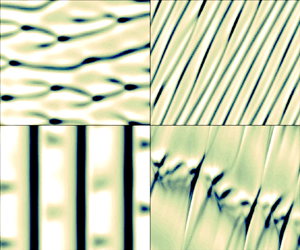Published online by Cambridge University Press: 02 August 2021

The rotation applied to a circular cylinder, rigidly mounted in a current perpendicular to its axis, can result in the suppression of vortex shedding and of the associated force fluctuations. It also causes the emergence of a myriad of two- and three-dimensional flow regimes. The present paper explores numerically the impact of a deviation from the normal incidence configuration, by considering a rotating cylinder inclined in the current. The Reynolds number based on the body diameter and the magnitude of the current velocity component normal to its axis ( $U_\perp$) is set to
$U_\perp$) is set to  $100$. The range of values of the rotation rate (ratio between body surface velocity and
$100$. The range of values of the rotation rate (ratio between body surface velocity and  $U_\perp$,
$U_\perp$,  $\alpha \in [0,5.5]$) encompasses the two unsteady flow regions and three-dimensional transition identified at normal incidence. The inclination angle (
$\alpha \in [0,5.5]$) encompasses the two unsteady flow regions and three-dimensional transition identified at normal incidence. The inclination angle ( $\theta$) refers to the angle between the current direction and the plane perpendicular to the cylinder axis. A low inclination angle (
$\theta$) refers to the angle between the current direction and the plane perpendicular to the cylinder axis. A low inclination angle ( $\theta \in \{15^\circ ,30^\circ \}$), i.e. slight deviation from normal incidence (
$\theta \in \{15^\circ ,30^\circ \}$), i.e. slight deviation from normal incidence ( $\theta =0^\circ$), has a limited influence on the global evolution of the flow with
$\theta =0^\circ$), has a limited influence on the global evolution of the flow with  $\alpha$, which can be predicted via the independence principle (IP), based on
$\alpha$, which can be predicted via the independence principle (IP), based on  $U_\perp$ only. This highlights the robustness of prior observations made for
$U_\perp$ only. This highlights the robustness of prior observations made for  $\theta =0^\circ$. Some effects of the axial flow are, however, uncovered in the high-
$\theta =0^\circ$. Some effects of the axial flow are, however, uncovered in the high- $\alpha$ range; in particular, the single-sided vortex shedding is replaced by an irregular streamwise-oriented structure. In contrast, a large inclination angle (
$\alpha$ range; in particular, the single-sided vortex shedding is replaced by an irregular streamwise-oriented structure. In contrast, a large inclination angle ( $\theta =75^\circ$) leads to a major reorganization of flow evolution scenario over the entire
$\theta =75^\circ$) leads to a major reorganization of flow evolution scenario over the entire  $\alpha$ range, with the disappearance of all steady regimes, the occurrence of structures reflecting the pronounced asymmetry of the configuration (oblique shedding, strongly slanted vorticity tongues) and a dramatic departure of fluid forces from the IP prediction.
$\alpha$ range, with the disappearance of all steady regimes, the occurrence of structures reflecting the pronounced asymmetry of the configuration (oblique shedding, strongly slanted vorticity tongues) and a dramatic departure of fluid forces from the IP prediction.